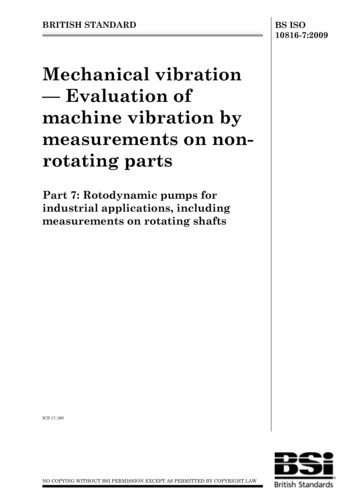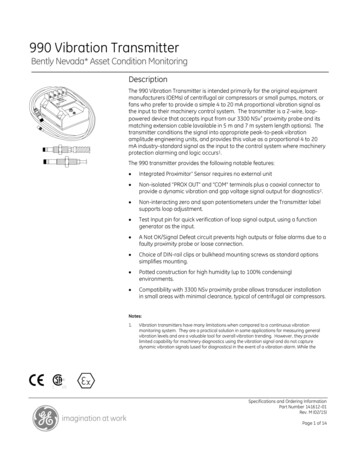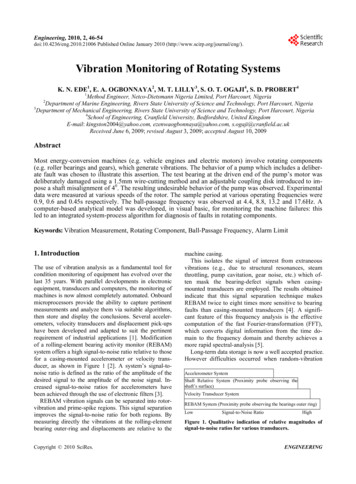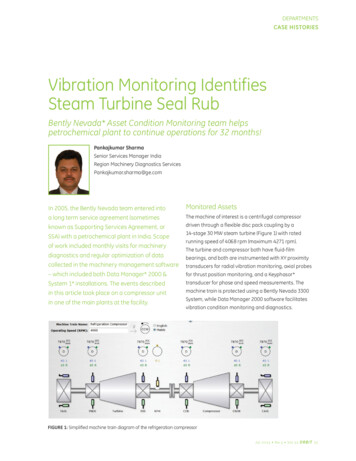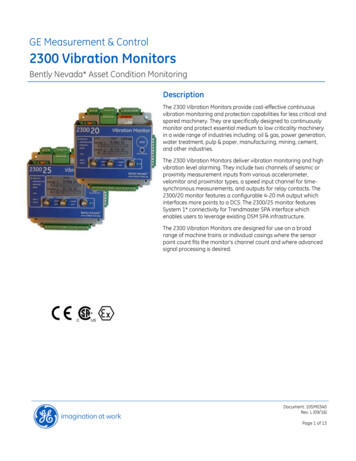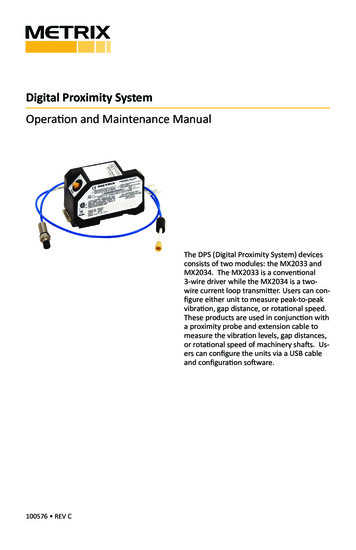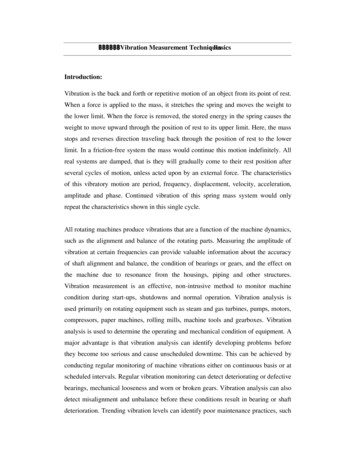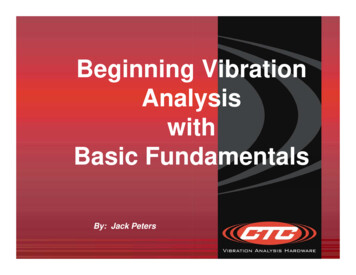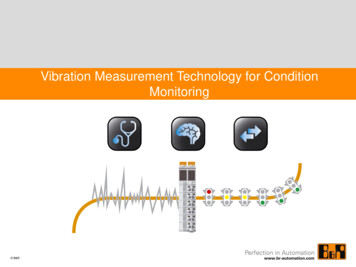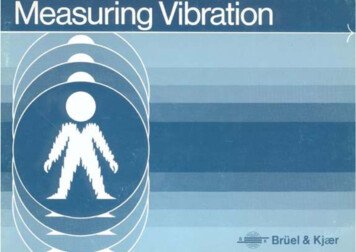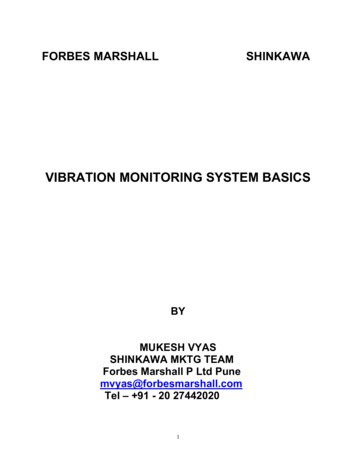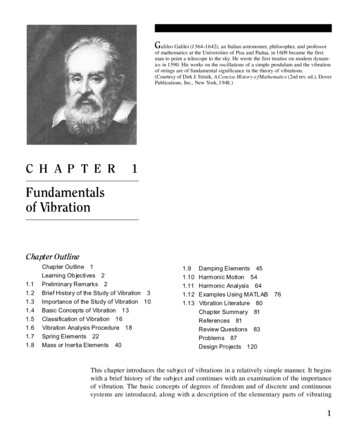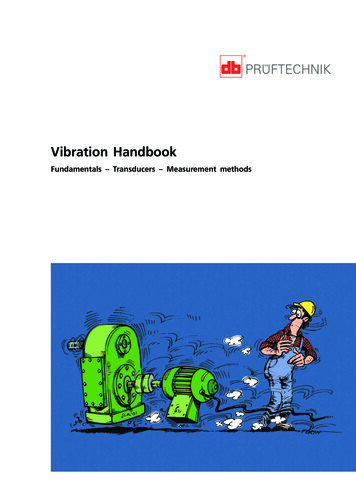
Transcription
Vibration HandbookFundamentals – Transducers – Measurement methods PRÜFTECHNIK AG Vibration Handbook1
ForewordMaintenance plays an increasingly important economic role inmodern industry, as managers realize that the key to retaininglong-term investment capital value lies in regular service andinspection. In addition, conscientious maintenance practiceshelp avoid unplanned machine stoppage and the resulting production downtime while improving production quality andplant safety.The German DIN Standard 31 051 defines maintenance as ‘allmeasures for retention and re-creation of the specification condition as well as for determining and evaluating the actual condition of technical aspects of a system.’ Vibration measurementis one of the primary measurement methods for determiningactual machine condition and allows a comprehensive evaluation through the potential of Fourier transformation.PRÜFTECHNIK has a long history of putting innovative technological ideas into industrial maintenance practice - with thepractical advantage for the user always foremost in mind. Thisguiding principle was first confirmed by OPTALIGN, theworld's first laser shaft alignment system.This handbook is intended to provide you, the user, with a solid basis of vibration knowledge and a useful reference for putting this knowledge into practice. We wish you much enjoyment and success in doing so.PRÜFTECHNIK AGVibration HandbookOrder number VIB 9.433G PRÜFTECHNIK AGAll rights reserved.
Table of contentsTable of roduction to vibration measurement . 3Periodic vibration in the time domain . 4Composite vibrations . 6Vibration parameters . 7Conversion factors . 9Periodic vibration in the frequency domain . 10Fourier transformation . 10Frequency analysis . 11Rigidity, mass, damping . 13Summary . 162.Vibration transducers for differentmeasurement problems. 17Piezo transducers . 17Induction transducers (velocity probes) . 19Eddy current transducers (proximity probes) . 20Transducer mounting . 212.12.22.32.43.3.43.4.13.4.23.4.3Evaluating machine conditionthrough vibration analysis . 25Vibration severity according to ISO 2372 . 25Definition . 26Classification . 27Frequency analysis . 29Fundamentals . 29Terminology . 30Spectra of standard vibration forms . 37Notes on successful vibration analysis . 39Vibration causes andtheir characteristic frequencies . 40Case histories of machine damage . 41Radial compressor coupling damage . 41Chiller misalignment . 43Summary . 444.Index . 455.Bibliography . 473.13.1.13.1.23.23.2.13.2.23.2.33.2.43.3 PRÜFTECHNIK AG Vibration Handbook3
Introduction to vibration measurement1. Introduction to vibration measurementVibration can occur in a multitude of forms. Whether they bedesirable (in the form of a tone emitted by a tuning fork) orundesirable (such as the noise and vibration of a jackhammeror the characteristic jolt made by a refrigerator starting up),vibrations are a part of everyday life.VIB 8. 51 5 / M 5RPR ÜFTHECExamples of vibrationIn industrial environments, the study of vibrations and theircauses and remedies is very important to ensure the smoothoperation and long operating life of critical production aggregates. Mechanical vibration serves as an excellent indicator ofmachine condition, because it includes the influences of dynamic loading, foundation behavior and all external influences. Most rotating equipment vibration occurs due to rotor imbalance or insufficient shaft alignment.The following pages offer a brief introduction to appropriatetheoretical fundamentals, which aid in understanding the subsequent discussion of measurement processes and analysis.This introduction has purposely been kept simple for the novice to the field of vibration measurement; the bibliography listssources for more in-depth study of these topics. PRÜFTECHNIK AG Vibration Handbook3
Introduction to vibration measurement1.1 Periodic vibration in the time domainVibration is generally considered to be the movement of a massor a body about its position at rest. Periodic vibration occurswhen the vibration repeats itself at regular intervals of time(e.g. tuning fork).x(t) x sin (ωωt φ )XtTf 1/TFig. 1 Periodic vibrationThe time length of a single vibration cycle is known as the vibration period T. The reciprocal 1/T is known as the vibrationfrequency and is expressed in cycles per second, or Hertz (Hz).The following sine function describes the undamped periodicvibration shown above:x(t) x sin (ωt φ);x(t): Displacement, instantaneous vibration valuex:Amplitude, maximum instantaneous valueω:Angular frequency; ω 2 π/T 2 π fφ:Phase angle, initial position of the oscillation att 0.The equation indicates the displacement - the vibration - as afunction of time.4 PRÜFTECHNIK AG Vibration Handbook
Introduction to vibration measurementThe fundamental physical source of this vibration and of therecorded signal could be thought of, for example, as follows:Fig. 2 Mass on spring pendulumThe vibration velocity v is the change in displacement x over aperiod of time. Its waveform is shifted by 90 from the positionof the displacement, i.e. velocity reaches its minimum (v 0)when amplitude is greatest. The velocity attains its maximumwhen the system oscillates through its zero level:v(t) x ω cos (ωt φ);The vibration acceleration a is the change in velocity over time.From a mathematical point of view, it is the second derivativeof displacement with respect to time. The acceleration waveform is shifted by 90 from the corresponding velocity wave(and therefore by 180 from the displacement curve). Thismeans that acceleration reaches its maximum when displacement is at its minimum; both pass the zero point at the sametime.a(t) -x ω2 sin (ωt φ);The displacement amplitude alone may be considered as follows:Vibration displacementx in mmVibration velocityv x ω in mm/sVibration accelerationa x ω2 in mm/s2At mid-range frequencies, vibration is normally measured interms of velocity; high frequencies call for acceleration mea- PRÜFTECHNIK AG Vibration Handbook5
Introduction to vibration measurementsurement. These deliver the best possible dynamic performance.1.1.1 Composite vibrationsWhen several periodic vibrations occur simultaneously, a com-S1XftXTS2f 2tXf S12 fS2tFig. 3 Superimposed sine wavesposite vibration results which is also periodic. This type of complex vibration is quite normal for practically all machinery.When vibrations overlap, the time domain depiction (with am-6 PRÜFTECHNIK AG Vibration Handbook
Introduction to vibration measurementplitude plotted along the time axis) cannot show individualwave components of the composite signal.1.1.2 Vibration parametersxx(t) x cos (ωω t φ ); xt 0φtfT 1/TFig. 4 Parameters of a sine waveAmplitude, frequency and phase angle determine the exactshape of a sine wave.The vibration frequency is important information for machinediagnosis, because certain causes of vibration - for example,rotor imbalance - occur at fixed multiples of the speed (frequency) at which massive components rotate.The phase angle φ describes the starting position of the oscillating point at time t 0. This phase angle and the phase difference between two measurement locations is extremely important for balancing and vibration diagnosis. PRÜFTECHNIK AG Vibration Handbook7
Introduction to vibration measurementStandard vibration parametersPeak-to-peak valuevalue::Difference between the largest and smallest vibration value,abbreviated as xppPeak valuevalue::Maximum vibration (also known as amplitude), abbreviated asxm.Median value:Quantifies the vibration strength over time:Definition: xMed 1x dt;TFor a sine wave: xMed 2 xmπEffective value:Quantifies the energy of vibration over time (also known as:RMS root-mean-square).Definition: xeff 1Tx2 dtFor a sine wave: xeff 12xmSxxMedxefft 0xmxmxppttt 0Fig. 5 Parameters of vibration strength measurementThe peak-to-peak value of a vibration is preferable when themaximum displacement is of interest, e.g. for problems relatedto machine component loading or internal separation distances.The peak value is best for examination of short-lived phenomena or transient signals.The effective value (RMS) shows most clearly the energy content of the vibration.8 PRÜFTECHNIK AG Vibration Handbook
Introduction to vibration measurement1.1.3 Conversion factorstoConversion ectivevaluePeak-to-peakvalue10.50.320.35Peak value210.640.71Median value3.141.5711.11Effective value2.831.410.901Fig. 6 Conversion factors PRÜFTECHNIK AG Vibration Handbook9
Introduction to vibration measurement1.2 Periodic vibration in the frequency domainAs mentioned earlier, when the vibration signal is composed ofseveral waves occurring simultaneously, the time signal alonedoes not show much information regarding its individual components. The frequency diagram obtained from the same timesignal, however, is generally much more useful because itclearly shows the individual vibrations (frequency components) which make up the complex signal.1.2.1 Fourier transformationThe French mathematician Jean Baptiste Fourier devised amethod for breaking down any waveform into a series of sinewave components, and conversely.In other words, everyday machine vibrations can be analyzedto determine which frequencies account for what portion ofthe overall measured vibration. Fourier's formulae supply themathematical basis for transforming the time signal into thefrequency spectrum.AmplitudeFrequencyTimeFig. 710Vibration in time and frequency domains PRÜFTECHNIK AG Vibration Handbook
Introduction to vibration measurementThe great advantage of displaying the frequency spectrum isthat all the individual components of vibration are readily recognizable.Time signalFrequency spectrumXt fXt fX tfFig. 8 Time signals and their corresponding frequency spectra1.2.2 Frequency analysisThe objective of frequency spectrum analysis is to break downa complex vibration signal into its individual frequency components according to their respective power. Experience hasshown that the operating condition can be observed very closely, since a machine in good condition exhibits a stable spectrum over extended periods of FrequencyFig. 9 Comparison of time domain vs. frequency domain PRÜFTECHNIK AG Vibration Handbook11
Introduction to vibration measurementReliable machine diagnosis is possible when the individualpeak frequencies in the vibration spectrum can be traced backto their corresponding machine parts.TransmissiongearsAnti-friction bearingUnbalanceFig. 10Machine vibrationsWhen measuring vibration, you should also consider that thesignal measured on the outer surface of the machine housingmay not coincide with the original 'inner' signal. The reason forthis lies in the transmission path.Example:If the inner ring of a bearing is damaged, the vibration must betransmitted from the inner ring via the rolling elements. thenthe signal is transferred from the outer ring outward via thebearing race and corresponding load-bearing housing portionto the measurement location. Here is where the vibrationtransducer converts the vibration into a measurable quantity e.g. voltage. Factors such as mass or rigidity of machine partsand the damping caused by individual parts - and, of course, atcomponent interfaces - can affect the output signal. This meansthat two identical machines mounted on different foundationsunder otherwise identical conditions can emit different vibration signals. These conditions must be considered when evaluating measurements.12 PRÜFTECHNIK AG Vibration Handbook
Introduction to vibration measurement1.3 Rigidity, mass and dampingA turbocompressor, for example, contains a vast number of thecomponents and interfaces just mentioned. Each of these components can in turn be seen as a separate vibration system untoitself. Detailed information on these components (mass-springsystems) and their vibration behavior is extremely beneficialtoward accurate machine vibration analysis - and nearly crucial to explaining and understanding phenomena such as resonance. Machines possess three qualities which determine theirvibration behavior - that is, their reaction to excitation forcesRigidity ("K" in kg/m),Mass ("m" in kg),Damping ("c" in kg s/m).cKmFFig. 11Mass-spring systemRigidity is a measure of force needed to bend or to stretch astructure by a certain amount (spring constant). Damping is ameasure of the force that works to counteract this.The relationship can be simp
Vibration measurement is one of the primary measurement methods for determining actual machine condition and allows a comprehensive evalua-tion through the potential of Fourier transformation. PRÜFTECHNIK has a long history of putting innovative techno-logical ideas into industrial maintenance practice - with the practical advantage for the user always foremost in mind. This guiding principle .
